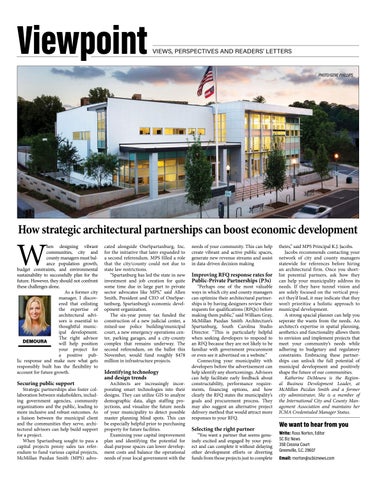Viewpoint
VIEWS, PERSPECTIVES AND READERS’ LETTERS
PHOTO/GENE PHILLIPS
How strategic architectural partnerships can boost economic development
W
hen designing vibrant communities, city and county managers must balance population growth, budget constraints, and environmental sustainability to successfully plan for the future. However, they should not confront these challenges alone. As a former city manager, I discovered that enlisting the expertise of architectural advisors is essential to thoughtful municipal development. The right advisor DEMOURA will help position your project for a positive public response and make sure what gets responsibly built has the flexibility to account for future growth.
Securing public support
Strategic partnerships also foster collaboration between stakeholders, including government agencies, community organizations and the public, leading to more inclusive and robust outcomes. As a liaison between the municipal client and the communities they serve, architectural advisors can help build support for a project. When Spartanburg sought to pass a capital projects penny sales tax referendum to fund various capital projects, McMillan Pazdan Smith (MPS) advo-
cated alongside OneSpartanburg, Inc. for the initiative that later expanded to a second referendum. MPS filled a role that the city/county could not due to state law restrictions. “Spartanburg has led the state in new investment and job creation for quite some time due in large part to private sector advocates like MPS,” said Allen Smith, President and CEO of OneSpartanburg, Spartanburg’s economic development organization. The six-year penny tax funded the construction of a new judicial center, a mixed-use police building/municipal court, a new emergency operations center, parking garages, and a city-county complex that remains underway. The second referendum, on the ballot this November, would fund roughly $478 million in infrastructure projects.
Identifying technology and design trends
Architects are increasingly incorporating smart technologies into their designs. They can utilize GIS to analyze demographic data, align staffing projections, and visualize the future needs of your municipality to detect possible master planning blind spots. This can be especially helpful prior to purchasing property for future facilities. Examining your capital improvement plan and identifying the potential for dual-purpose spaces can lower development costs and balance the operational needs of your local government with the
needs of your community. This can help create vibrant and active public spaces, generate new revenue streams and assist in data-driven decision making
Improving RFQ response rates for Public-Private Partnerships (P3s)
“Perhaps one of the most valuable ways in which city and county managers can optimize their architectural partnerships is by having designers review their requests for qualifications (RFQs) before making them public,” said William Gray, McMillan Pazdan Smith Architecture’s Spartanburg, South Carolina Studio Director. “This is particularly helpful when seeking developers to respond to an RFQ because they are not likely to be familiar with government procurement or even see it advertised on a website.” Connecting your municipality with developers before the advertisement can help identify any shortcomings. Advisors can help facilitate early feedback about constructability, performance requirements, financing options, and how clearly the RFQ states the municipality’s goals and procurement process. They may also suggest an alternative project delivery method that would attract more responses to your RFQ.
Selecting the right partner
“You want a partner that seems genuinely excited and engaged by your project and can complete it without delaying other development efforts or diverting funds from those projects just to complete
theirs,” said MPS Principal K.J. Jacobs. Jacobs recommends contacting your network of city and county managers statewide for references before hiring an architectural firm. Once you shortlist potential partners, ask how they can help your municipality address its needs. If they have tunnel vision and are solely focused on the vertical project they’d lead, it may indicate that they won’t prioritize a holistic approach to municipal development. A strong spacial planner can help you seperate the wants from the needs. An architect’s expertise in spatial planning, aesthetics and functionality allows them to envision and implement projects that meet your community’s needs while adhering to budgetary and regulatory constraints. Embracing these partnerships can unlock the full potential of municipal development and positively shape the future of our communities. Katherine DeMoura is the Regional Business Development Leader, at McMillan Pazdan Smith and a former city administrator, She is a member of the International City and County Management Association and maintains her ICMA Credentialed Manager Status.
We want to hear from you Write: Ross Norton, Editor SC Biz News 35B Cessna Court Greenville, S.C. 29607 Email: rnorton@scbiznews.com
